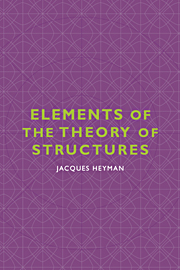Book contents
- Frontmatter
- Contents
- Preface
- 1 The theory of structures
- 2 Virtual work
- 3 Betti, Maxwell, Müller-Breslau, Melchers
- 4 Jettied construction
- 5 Clebsch, Macaulay, Wittrick, Lowe
- 6 The elastica
- 7 Mechanisms of collapse
- 8 The absolute minimum-weight design of frames
- 9 Inverse design of grillages
- 10 The relation between incremental and static plastic collapse
- 11 The bending of a beam of trapezoidal cross-section
- 12 The simple plastic bending of beams
- 13 Leaning walls; domes and fan vaults; the error function ∫e−t2dt
- Bibliography
- Name index
- Subject index
1 - The theory of structures
Published online by Cambridge University Press: 18 December 2009
- Frontmatter
- Contents
- Preface
- 1 The theory of structures
- 2 Virtual work
- 3 Betti, Maxwell, Müller-Breslau, Melchers
- 4 Jettied construction
- 5 Clebsch, Macaulay, Wittrick, Lowe
- 6 The elastica
- 7 Mechanisms of collapse
- 8 The absolute minimum-weight design of frames
- 9 Inverse design of grillages
- 10 The relation between incremental and static plastic collapse
- 11 The bending of a beam of trapezoidal cross-section
- 12 The simple plastic bending of beams
- 13 Leaning walls; domes and fan vaults; the error function ∫e−t2dt
- Bibliography
- Name index
- Subject index
Summary
A structure (from the Latin struere) is anything built: say an arched bridge or a cathedral from stone; a ship or a roof (and perhaps a spire) from timber; an earth dam or an excavation in soil for a fortification; or (as isolated usages) iron bars (in China first) or vegetable ropes to form suspension chains in bridges. Before the Renaissance all these structures were built without calculation, but not without ‘theory’, or what today would be called a ‘code of practice’. Mignot's statement in 1400, at the expertise held in Milan, that ars sine scientia nihil est (practice is nothing without theory), testifies to the existence of a medieval rule-book for the construction of cathedrals; the few pages of a builder's manual bound in with the book of Ezekiel in about 600 BC show that there were yet earlier rules. These rules, for construction in the two available materials, stone and wood, were essentially rules of proportion and, as such, are effectively correct.
Stresses in ancient structures are low, and this has helped to ensure their survival. The stone in a medieval cathedral, or in the arch ring of a masonry bridge, is working at a level of one or two orders of magnitude below its crushing strength. Similarly, deflexions of such structures due to loading are negligibly small (although the movements imposed by warping of the material or by slow movements of foundations may often be seen).
- Type
- Chapter
- Information
- Elements of the Theory of Structures , pp. 1 - 10Publisher: Cambridge University PressPrint publication year: 1996



